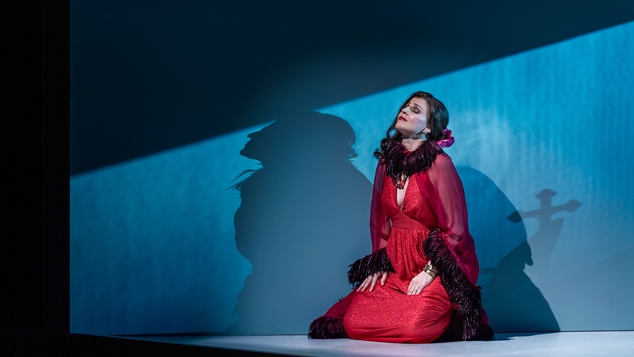Tosca
- clairaprider
- Sep 1, 2023
- 4 min read
Western Australian Opera with Western Australian Symphony Orchestra
His Majesty's Theatre
July 2022
Originally Published at: Review | 'Tosca' tells classic tale of jealousy, lust and corruption - OUTInPerth | LGBTQIA+ News and Culture | OUTInPerth | LGBTQIA+ News and Culture
3.5 STARS
Warning: This review contains mentions of suicide and sexual assault.
First performed in 1900, Tosca, a three-act opera was the fifth opera written by Italian composer Giacomo Puccini. During an era when the western world was undergoing great social, technological, and political change, Puccini grew up in a time where Europe saw a radical desacralization of sacred spaces and a great rise of secularism.
Writers and composers had the task of creating a response to their rapidly changing world which saw the rise of Verismo opera. Verismo meaning realism, refers to a style of opera and literature where works reflect the real world with no frills. In true Verismo style, Tosca depicts torture, rape, murder, and suicide; subjects often not addressed so openly at the time. Original audiences found it vile and confronting; not being accustomed to seeing such objectivity in a genre they’d usually expect to be fictional and subjective.
Photos by Clinton Bradbury
Librettist Giuseppe Giacosa and Luigi Illica collaborated on Tosca which was based on Victorien Sardou’s five act play La Tosca. Originally set in the late 19th Century, this work explores themes of jealousy, lust and corruption. Patrick Nolan’s production sees the story set in the 1970s Rome in a time where political and religious tensions were running high. This production highlights the timeless universality of the themes of seduction and corruption and the ever-expanding divide between church and state.
The set is made up of two split levels; inside the church on the lower level where the majority of the first act is set, and directly above them in the home of tyrannical chief of police, Scarpia. The walls of the church are lined with paintings of catholic art subjects and there is a counter at the front of the stage dressed with a crucifix, flowers and holy water around which much of the first act revolves. The lighting is stark against the clean-cut lines of the enormous set. Juxtaposed by the monochrome surroundings, the costumes are bold and exciting showing many of the iconic colours, patterns, and styles of 70s fashion.
The lights had gone down and the audience was eagerly awaiting the opening when musical director Chris Van Tuinen entered the stage to address the audience. My heart sank when I saw him as this usually means there’s an announcement of illness; particularly unsurprising in our current climate. Devastatingly Warwick Fyfe who was singing the role of Scarpia had been hit with a respiratory illness, but luckily for us was still able to perform while singing at half voice. Alas, the show must go on!
Fyfe is a veteran to Australian opera stages, known for his versatile acting and divine baritone voice. Fyfe performed the role of corrupt police chief Scarpia; embodying the menace and grandeur of this despicable character. It was clear he wasn’t well enough to be performing; despite his commanding stage presence and impeccable timing, Fyfe’s performance was lacking the sparkle and spectacle in which he usually steals the show with.
In these COVID times I cant fathom why they didn’t have an understudy ready to go, because if he’d not been able to perform, opening night couldn’t have gone ahead. Fyfe was clearly devastated with his performance being far from his best when he cut the audience off from applauding him during the closing bows – something I’ve never experienced before which was particularly heartbreaking to see.
In an orange jumpsuit, Wesfarmers Young Artist Jake Bigwood is the first performer we see. He creeps onto stage singing the role of Angelotti; an escaped political prisoner with a rich yet crisp tone. In jeans and a grubby cardigan, Paul O’Neill enters the church singing the role of Cavaradossi where he gets to work on his portrait painting. Reprising the role he sung when WA Opera performed Tosca in 2017, O’Neill’s luscious upper register combined with his passion filled, emotive performance carried the show with the best singing of the evening.
O’Neill’s torture scene happens behind a semi-opaque screen so the audience can see the silhouette of him being beaten and abused. I love this concept; so simple yet effective, however the choreography and execution left a lot to be desired as it lacked believability all of the fight sequences.
Singing the titular role of Tosca Floria is Maija Kovalevska, Latvian-born soprano in her WA Opera debut. Kovalevska brought a light and playful energy to this much loved ingenue, her bright, spinto tone carried across the orchestra beautifully. Kovalevska gave a fine performance of Visi D’arte, despite seeming to tire throughout the second and third act. Again due to timing and execution of the choreography, I found the Cavaradossi’s murder and Tosca’s suicide lacking believability and breath-taking drama.
Led by Chorus Master Hugh Lydon, the WA Opera chorus were joined by WAO Children’s chorus performing as choristers of the cathedral choir. Under the baton of Australian born conductor Rebecca Lang, WASO brings to life this compelling and dramatic score. From start to finish the tempi seemed to drag, lacking the power and drive that Puccini scores often embody. While this production felt slightly undercooked, the show was well received and provided a very entertaining night out at the opera in Perth’s stunning His Majesty’s Theatre.











Comments